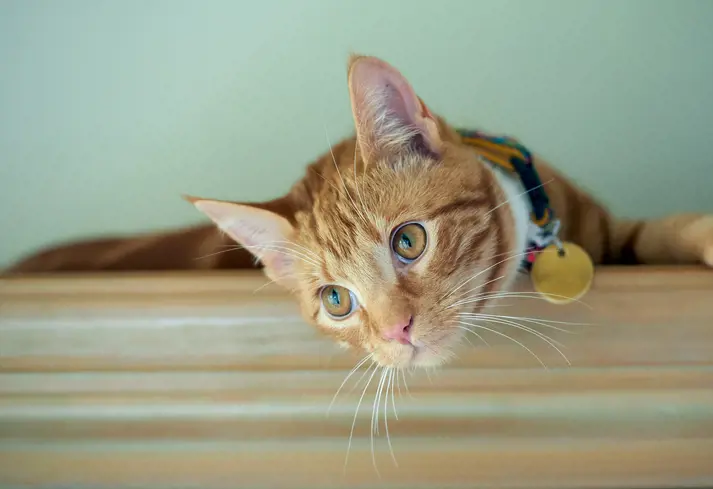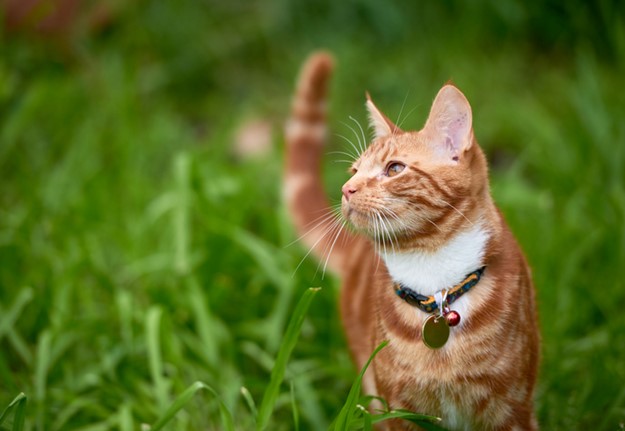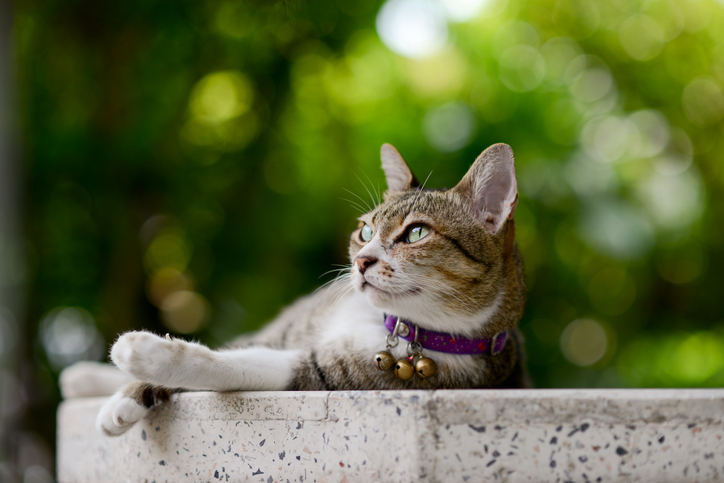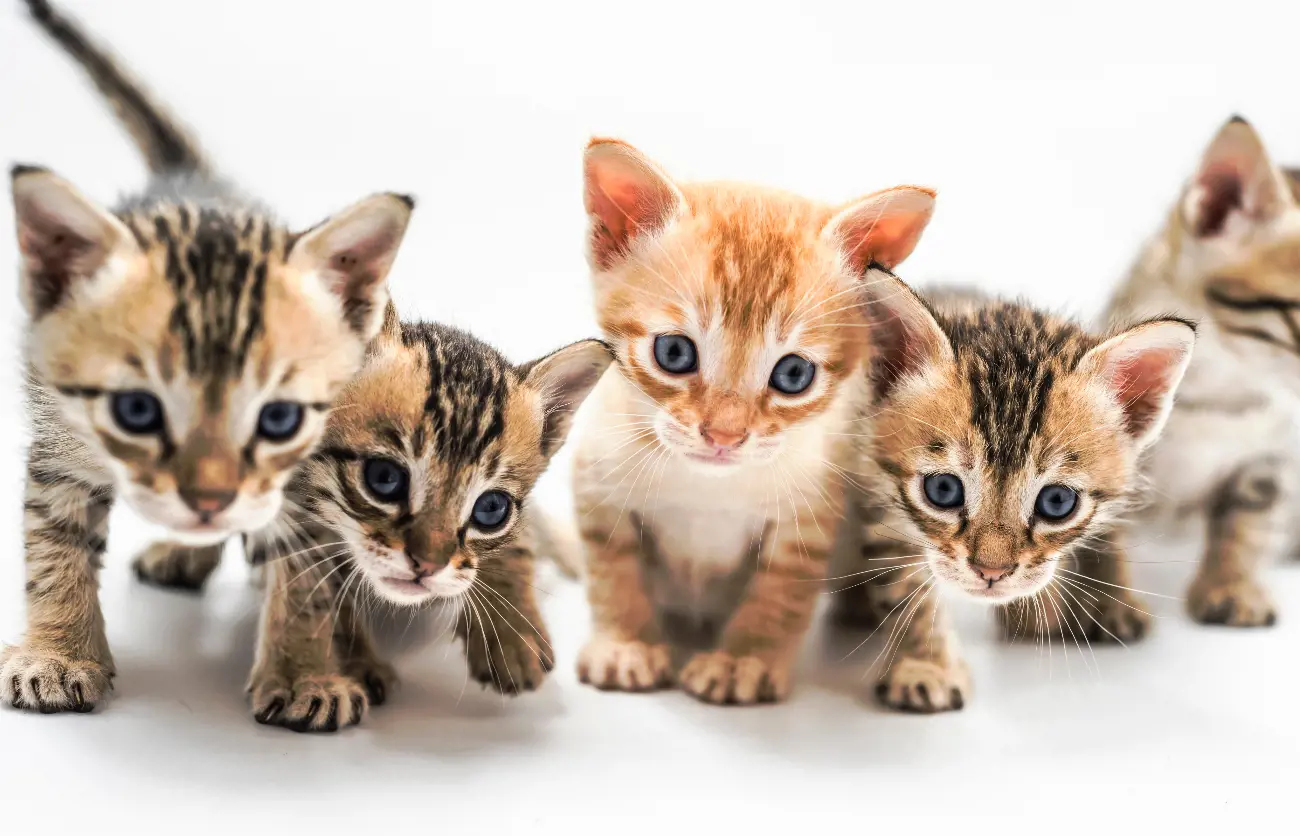How to choose the right cat collar
9th August, 2021

There’s no rule that says your cat should wear a collar, but it does come with some benefits. Not only does a collar provide a useful safety measure for your feline friend, it can also help you keep track of them if they like to go on adventures.
However, there are also some negatives that come with cat collars, too, such as potential injury. Deciding whether or not you want your cat to wear a collar is down to personal choice. And to make the right choice for you and your cat, you need enough information to make an informed decision.
Here’s our guide to everything you need to know about choosing the right cat collar for your moggy. We can also help you navigate the world of pet insurance. Give our helpful team a call today.

Reasons for choosing a cat collar
Cat collars can take up a lot of shelf space in a pet shop. There are bell collars, reflective collars, diamante collars and traditional collars. They range from the functional (think: identification or flea collars) to the stylish (think: leopard print or rhinestone collars).
With so many different types of cat collar on offer, choosing the right one for your kitty can be confusing. Here’s what you need to know about different collars, the benefits they offer, and some of the negatives you need to be aware of, too.
Collars for identification
Arguably, the most obvious reason for your cat wearing a collar is to help you identify them should they become lost. Microchipping is the safest and most permanent identification method, but you might decide to buy a collar as a visible marker that your cat has an owner. If your cat was lost or injured, for example, a tag listing your details could be the fastest way you can be contacted.
Collars that prevent parasites
Some cat collars double up as flea collars. However, many of these collars contain permethrin or organophosphate, which can be harmful to felines. The level of chemicals contained in a collar is relatively low, however, many cat charities recommend using alternative parasite prevention methods on your cat. Also, your cat is only protected from fleas for as long as they wear the collar and there are plenty of flea products that could prove to be safer and more effective.
Collars that protect wildlife
According to figures from the Mammal Society, cats in the UK catch up to 100 million prey items during the spring and summer months, of which 27 million are birds Meanwhile, research carried out by the RSPB has revealed that attaching a bell to a cat’s collar can reduce the number of birds a cat can catch and kill.
You may be keen to limit how much wildlife your cat brings home to you as ‘presents’. A cat collar might not completely prevent this from happening, but it can certainly help.
However, advice from Cats Protection states that attaching a dangling item from a collar could result in it getting trapped, causing injury.
The other thing to consider is that if your cat is a stealthy hunter, chances are they will find ways round the jangling bell and still return home with those furry or feathery ‘presents’.
Collars that glow in the dark
Glow-in-the-dark or reflective collars can help increase visibility when your cat is out and about at night. Reflective strips are picked up by car headlights and will help them be seen if they decide to dart across a road. Collars might have a reflective patch or be made entirely from reflective material.
Collars that activate a cat flap
Automated cat flaps are useful if you have local moggies who like to pop in for a visit. There was a time when the only way for your cat to activate a cat flap was to attach a magnetic or electronic key to your cat’s collar. Today however, there are cat flaps that can be activated by a microchip and avoid the need for cats to wear a collar at all.
Collars for walking your cat
If you live in a flat with no easy access for your feline, you may think about taking your cat out for a walk on a lead. If so, bypass the cat collars and look into getting a cat harness which can be attached to a lead instead. A harness will be far more comfortable and secure for you and your feline.
You need to make your decision based on the needs of your particular cat. But remember: cats can get into all sorts of scrapes with or without a collar. However, the right insurance for a pet can help them get the care they need, when they need it most.
Choosing the right cat collar
If you’ve decided you do want your cat to wear a collar, the decision-making is far from over. If anything, that’s the easy part. Things get a little trickier when it comes to choosing the right cat collar for your puss.
There are a number of different types of cat collar on the market. Here’s a rundown of the pros and cons of each one:
Breakaway collars
Also known as snap-open or quick-release collars, these come complete with a special buckle that automatically unfastens when something pulls against it. Breakaway collars don’t click into a locked position so they enable your moggy to slip free if their collar gets caught on a fence, branch or piece of furniture.
This quick-release mechanism makes them the safest choice of cat collar. In fact, every cat charity we’ve found recommends buying a collar with a quick release or snap opening. Should your cat’s collar get caught or tangled, your cat is less likely to become trapped with it.
Elastic collars
Some cat collars are made from elastic – either partially or completely. The idea behind them is similar to that of breakaway collars – if your cat should become trapped, it can easily slip out and escape. However, do bear in mind that this style of collar is not as safe as the breakaway style. Elastic, by its very nature, is extremely stretchy so your cat could get injured if their leg or mouth got stuck in the collar. Arguably, an elastic collar is also trickier to fit than other non-elastic alternatives.
Buckle collars
These are a traditional-style of collar with a buckle that can be opened and adjusted. They can look very similar to breakaway collars, but the difference is they will not open when pulled. To undo the collar, you would have to unbuckle it.
Buckle collars are more suited to dogs and indoor cats than indoor-outdoor cats. If your cat gets caught on an object whilst exploring outside, they could get stuck. In this situation, a buckle collar could soon become a choking hazard.
Decorative collars
Luckily, there is a style of cat collar that fits every puss’ personality and gives a collar a more personal touch. You can choose from neon, patterned, metallic, diamante and leather collars. The list goes on.
However, do remember that some decorative collars might be more style over substance. Not all will have a breakaway feature and some materials such as diamantes could cause injury or pose a choking risk if they fall off.
No collar
If your cat doesn’t go outside, you may decide they don’t need to wear a collar at all. Even if your cat does roam freely inside and out, having them microchipped is a fast, effective way to identify them. Microchips hold a host of useful information such as your name, address and phone number, meaning your feline friend is more likely to be returned to you if they get lost.
The downside to your cat not wearing a collar whilst out and about is that they may look like a stray and may get ‘adopted’ by a well-meaning neighbour. If you do opt for no collar, don’t be tempted to take the same approach with insurance for your pet. Knowing your pet is protected is your number one job as a pet owner.

Fitting a cat collar
So, you’ve decided on the type of cat collar you want to buy. Your next consideration is knowing how to choose a collar that fits properly.
Collars should be quite firmly fitted – you should be able to snugly slide two fingers in between the collar and your cat’s neck. This will ensure that the collar is not so tight it is uncomfortable or dangerous and not loose enough that your cat gets a paw caught in it and injures themselves.
If you are buying a collar for a kitten, you should regularly check the fit as your cat grows. Make sure you can always slide two fingers between your cat and the collar and adjust it if it is getting too tight. And don’t forget to upgrade from a kitten-sized collar to an adult-sized collar when the time comes.
What if my cat doesn’t want to wear a collar?
Some cats will instantly accept wearing a collar. Others will see it as an insult to their intelligence and resist having one round their neck. If you’re really keen for your cat to wear a collar and they are putting up a fight, it might take a few attempts over several days or weeks before you get it round their neck.
If you’re patient and stick with it, your cat will probably learn to accept their new collar. But if they are really resistant to the idea – they might try to chew it off, pull it off or look downright miserable when wearing it – don’t force the issue. It might have to be you – rather than your kitty – who backs down on this occasion.
Common injuries caused by cat collars
Last year, the RSPCA received 60 reports of cats injured by their collars. A badly-chosen collar could result in your cat sustaining an injury and needing urgent medical attention. Having pet insurance can cover the financial cost of that veterinary treatment.
Problems with cat collars happen for a number of reasons.
Injuries can happen if the collar has been poorly fitted. Either that it’s so loose a paw or jaw gets stuck in it, or so tight a cat struggles to breath or ends up with fur loss and wounds on its neck. Similar injuries can occur when collars are poor quality or come with elastic inserts.
Here are some of the most common injuries caused by cat collar:
- Hair loss: This is usually a fairly minor issue caused by rubbing or the chemicals in a flea collar. However, it can still cause your cat significant distress if it does occur.
- Trapped jaw: Your cat could sustain an injury if their collar becomes caught round their jaw.
- Trapped leg: Injuries caused by a cat getting its front leg stuck in the collar can be serious and very painful. If the collar ends up cutting into the skin, it can be tricky to treat.
- Choking/strangulation: If the collar becomes hooked or trapped on an object and doesn’t automatically open, a cat could end up strangling itself.
- Injured claw: If a cat’s claw gets trapped in a dangling bell or bad stitching, it may become injured and require a visit to the vets.
Making sure your cat is covered by award-winning pet insurance can help take some of the stress out of pet ownership. However, it’s up to you as a responsible cat owner to ensure that you always make choices with your cat in mind.
Purely Pets: Specialists in protecting your pet
At Purely Pets, we know how important a role your cat plays in your life. They’re your friend, companion and a key member of your family. Which is why we provide a range of cover to suit your cat’s needs.
Our dedicated team of specialists are here to make insuring your cat as simple as possible. We offer 15 levels of lifetime cover, so whatever your requirements (and your budget) we have the pet insurance for you.
Benefits include a 24-Hour Vet Helpline, online policy management portal, and no upper age limit. Speak to our UK-based dedicated team to find out more about the pet insurance policies we offer.
Get a free quote today.
Policy benefits, features and discounts offered may very between insurance schemes or cover selected and are subject to underwriting criteria. Information contained within this article is accurate at the time of publishing but may be subject to change.
Helpful Pages
Recent Posts
Pet Insurance Quote
- 98% claims paid *
- Claims paid directly to vets
- 24/7 vet video consultations
- Interest free monthly payments




